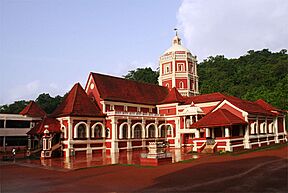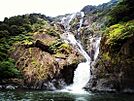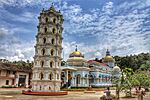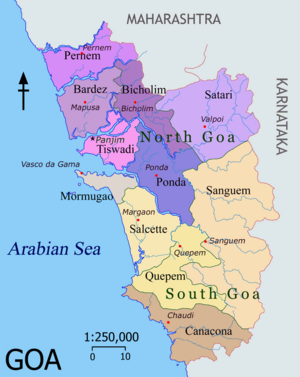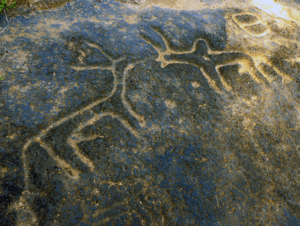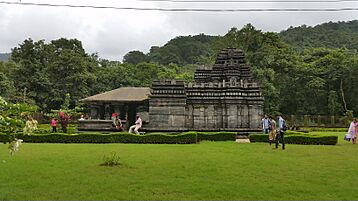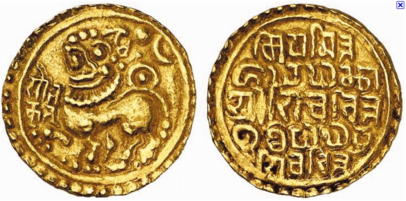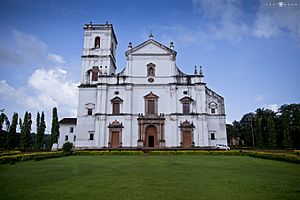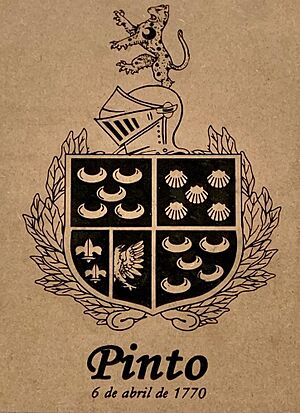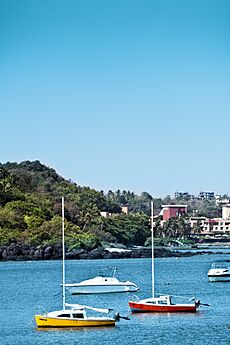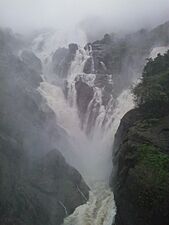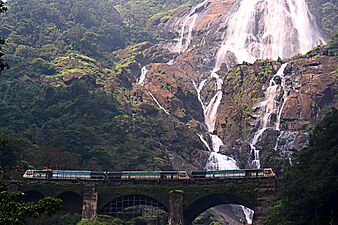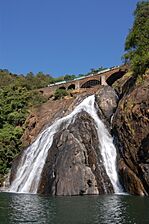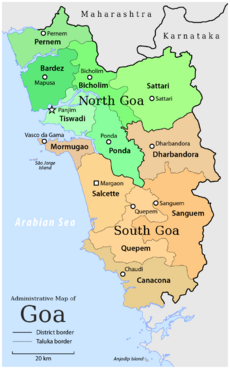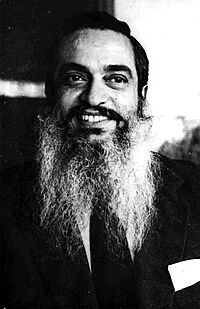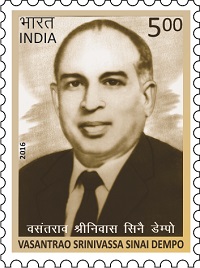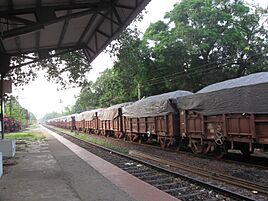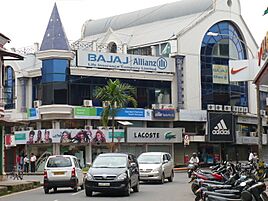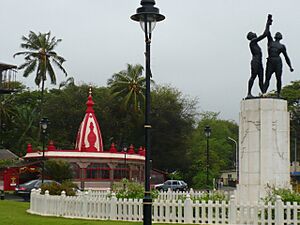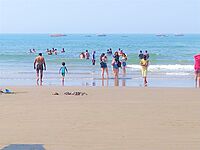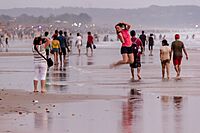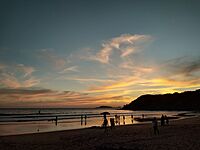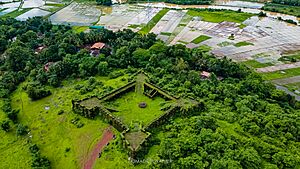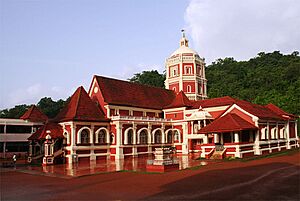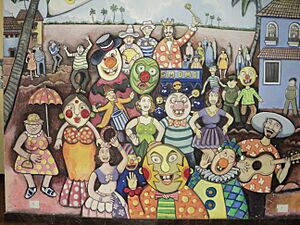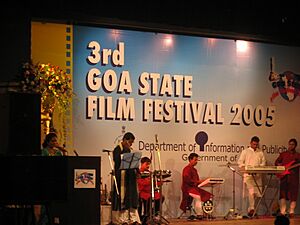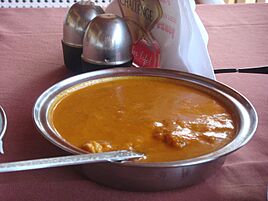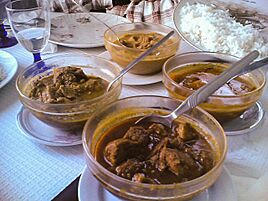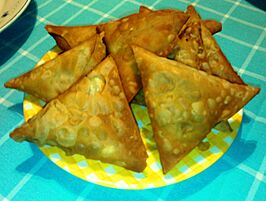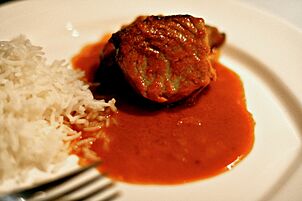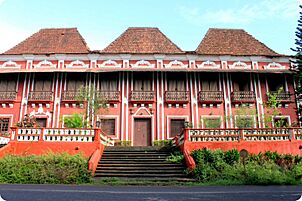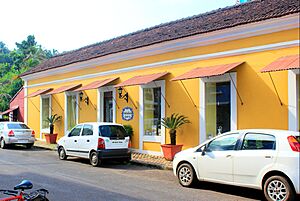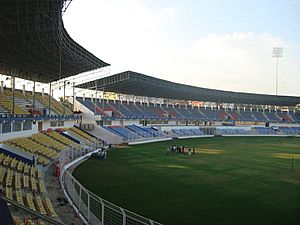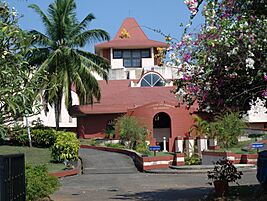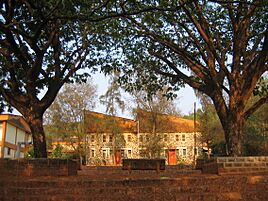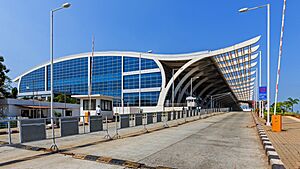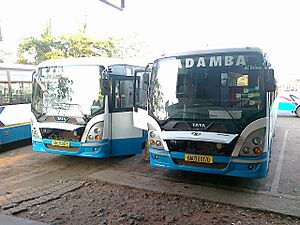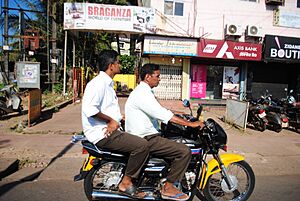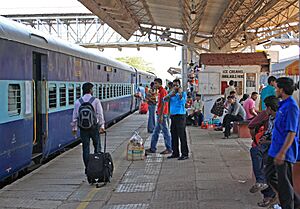Goa facts for kids
Quick facts for kids
Goa
|
|||||||||||||||||||||||
|---|---|---|---|---|---|---|---|---|---|---|---|---|---|---|---|---|---|---|---|---|---|---|---|
| State of Goa | |||||||||||||||||||||||
|
Shanta Durga Temple
Dudhsagar Falls
Mangueshi Temple
Gallery de Fontainhas
Corjuem Fort
Basilica of Bom Jesus
a beach in South Goa
|
|||||||||||||||||||||||
|
|||||||||||||||||||||||
| Nickname(s):
"Pearl of the Orient"
|
|||||||||||||||||||||||
| Motto(s):
Sarve Bhadrāṇi Paśyantu Mā Kaścid Duḥkhamāpnuyāt
(May everyone see goodness, may none suffer any pain) |
|||||||||||||||||||||||
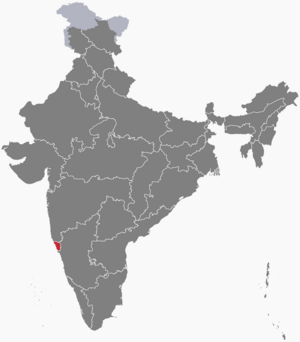
Location of Goa in India
|
|||||||||||||||||||||||
| Country | |||||||||||||||||||||||
| Region | West India | ||||||||||||||||||||||
| Before was | Goa, Daman and Diu | ||||||||||||||||||||||
| Admission to union | 19 December 1961 | ||||||||||||||||||||||
| Formation (by bifurcation) |
30 May 1987 | ||||||||||||||||||||||
| Capital | Panaji | ||||||||||||||||||||||
| Largest city | Vasco da Gama, Goa | ||||||||||||||||||||||
| Districts | 2 | ||||||||||||||||||||||
| Government | |||||||||||||||||||||||
| • Body | Government of Goa | ||||||||||||||||||||||
| State Legislature | Unicameral | ||||||||||||||||||||||
| • Assembly | Goa Legislative Assembly (40 seats) | ||||||||||||||||||||||
| National Parliament | Parliament of India | ||||||||||||||||||||||
| • Rajya Sabha | 1 seat | ||||||||||||||||||||||
| • Lok Sabha | 2 seats | ||||||||||||||||||||||
| High Court | Bombay High Court | ||||||||||||||||||||||
| Area | |||||||||||||||||||||||
| • Total | 3,702 km2 (1,429 sq mi) | ||||||||||||||||||||||
| Area rank | 28th | ||||||||||||||||||||||
| Elevation | 1,020 m (3,350 ft) | ||||||||||||||||||||||
| Population
(2011)
|
|||||||||||||||||||||||
| • Total | |||||||||||||||||||||||
| • Rank | 28th | ||||||||||||||||||||||
| • Density | 380/km2 (1,000/sq mi) | ||||||||||||||||||||||
| • Urban | 62.17% | ||||||||||||||||||||||
| • Rural | 37.83% | ||||||||||||||||||||||
| Demonym(s) | Goenkar, Goan | ||||||||||||||||||||||
| Language | |||||||||||||||||||||||
| • Official | Konkani | ||||||||||||||||||||||
| • Additional official | Marathi and English | ||||||||||||||||||||||
| • Official script | Devanagari script | ||||||||||||||||||||||
| GDP | |||||||||||||||||||||||
| • Total (2023–2024) | |||||||||||||||||||||||
| • Rank | 23rd | ||||||||||||||||||||||
| • Per capita | |||||||||||||||||||||||
| Time zone | UTC+05:30 (IST) | ||||||||||||||||||||||
| ISO 3166 code | IN-GA | ||||||||||||||||||||||
| Vehicle registration | GA | ||||||||||||||||||||||
| HDI (2022) | |||||||||||||||||||||||
| Literacy (2018) | |||||||||||||||||||||||
| Sex ratio (2011) | 974♀/1000 ♂ (34th) | ||||||||||||||||||||||
|
|||||||||||||||||||||||
Goa is a state located on the southwestern coast of India. It is part of the Konkan region. The Western Ghats mountains separate it from the Deccan Plateau. To the north, Goa shares a border with Maharashtra. To the east and south, it borders Karnataka. The Arabian Sea is to its west. Goa is India's smallest state by land area. It is also the fourth-smallest by population.
Goa has the highest GDP per capita among all Indian states. This means its people earn more on average. It is two and a half times higher than the rest of India. Goa is known for its good infrastructure. It also has a high quality of life. It ranks second among Indian states in the human development index.
Panaji is the capital city of Goa. Vasco da Gama is the largest city. The historic city of Margão shows a strong Portuguese influence. The Portuguese first arrived in the early 16th century as traders. They soon conquered Goa. It became an overseas territory of the Portuguese Empire. This was part of what was called Portuguese India. Goa remained under Portuguese rule for about 456 years. India took control of Goa in 1961. The main language spoken in Goa is Konkani.
Many tourists visit Goa each year. They come for its white-sand beaches and lively nightlife. They also visit its many places of worship. Goa is famous for its World Heritage-listed architecture. The state also has rich plant and animal life. This is because it is very close to the North Western Ghats rainforests. These are one of the world's rare biodiversity hotspots.
Contents
- What's in a Name?
- Goa's Past
- Goa's Land and Nature
- How Goa is Divided
- Government and Politics
- Plants and Animals
- Goa's Economy
- People of Goa
- Fun in Goa: Tourism
- Goa's Culture
- Famous People from Goa
- Media and Communication
- Sports in Goa
- Learning in Goa: Education
- How to Travel in Goa
- Sister States
- See also
What's in a Name?
After Afonso de Albuquerque captured the city of Goa in 1510, it became the capital of the Estado da Índia. The city then gave its name to the nearby areas.
The exact origin of the name "Goa" is not clear. In old writings, Goa was called by many names. Some of these include Gomanchala, Gopakapattana, Gopakapuri, and Gomantak. Other historical names were Sindapur and Mahassapatam.
Goa's Past
Ancient Times
Rock art found in Goa shows some of the earliest signs of human life in India. Goa is located in the Western Ghats. This area has rocks that show evidence of early human settlements. Rock carvings, called petroglyphs, are found in Usgalimal and Kajur. These carvings show animals and other designs.
Ancient tools like stone-axes and choppers, dating back 10,000 years, have also been found. These petroglyphs are now considered for the UNESCO world heritage list.
Early Goan society changed when people from Indo-Aryan and Dravidian groups mixed with the local people. This mix formed the basis of early Goan culture.
Early Kingdoms and Rulers
In the 3rd century BC, Goa was part of the Maurya Empire. This empire was ruled by the Buddhist emperor Ashoka. Buddhist monks helped spread Buddhism in Goa. From the 2nd century BC to the 6th century AD, the Bhojas of Goa ruled Goa.
Over the next few centuries, different groups ruled Goa. These included the Chalukyas of Badami and the Rashtrakutas. Later, the Kadambas ruled Goa. They supported Jainism in Goa.
In 1312, Goa came under the Delhi Sultanate. But their control was weak. By 1370, the Vijayanagara Empire took over. They held the land until 1469. Then, the Bahmani sultans of Gulbarga took control. After their empire fell apart, the Adil Shahis of Bijapur took over. They made the city known as Velha Goa (Old Goa) their second capital.
Portuguese Rule in Goa
In 1510, the Portuguese defeated the Bijapur sultan Yusuf Adil Shah. They were helped by a local ally named Timoji. The Portuguese then set up a permanent settlement in Velha Goa (Old Goa). This was the start of Portuguese colonial rule in Goa. It lasted for 456 years. India took over Goa in 1961.
The Goa Inquisition, a formal court, was set up in 1560. It was finally ended in 1812.
By the late 1700s, Goa was made of two parts. The Velhas Conquistas (Old Conquests) had been under Portuguese rule since the 1500s. The Novas Conquistas (New Conquests) were added later in the 1700s.
In 1787, there was a revolt by Catholic Goans. It was led by the Pinto family. They were unhappy about unfair treatment by the Portuguese. Some family members were executed. Others, like Abbe Faria, joined the French Revolution. This story is still a legend in Goa.
In 1843, the Portuguese moved their capital. It moved from Velha Goa (Old Goa) to Cidade da Nova Goa. This city is now known as Panaji (Panjim). By the mid-18th century, Portuguese rule in India was limited to Goa, Daman, and Diu. This area was called Estado da Índia.
Modern Goa
After India became independent from British rule in 1947, India asked Portugal to hand over its territories. Portugal refused to discuss this. On December 19, 1961, the Indian Army invaded Goa. This was called Operation Vijay. Goa, along with Daman and Diu, became a union territory of India.
On January 16, 1967, a referendum was held in Goa. People voted on whether to stay a union territory or join the state of Maharashtra. Most people chose to remain a union territory. On May 30, 1987, Goa became India's twenty-fifth state. Daman and Diu remained a union territory.
Goa's Land and Nature

Goa covers an area of about 3,702 square kilometers. It is located between 14°53′54″ N and 15°40′00″ N latitude. Its longitude is between 73°40′33″ E and 74°20′13″ E.
Goa is part of the Konkan coastal region. This area rises up to the Western Ghats mountains. These mountains separate Goa from the Deccan Plateau. The highest point in Goa is Sonsogor Peak, which is 1,026 meters high. Goa has a coastline that is 160 kilometers long.
Goa has seven main rivers. The most important are the Mandovi and the Zuari. These rivers are connected by the Cumbarjua canal. They form a large river system. The rivers get their water from the Southwest monsoon rains. Their basins cover 69% of the state's area. These rivers are some of the busiest in India. Goa has over 40 river mouths, eight sea islands, and about 90 river islands. The total length of navigable rivers in Goa is 253 kilometers. Goa also has over 300 old water tanks and more than 100 medicinal springs.
The Mormugao harbor is at the mouth of the Zuari river. It is considered one of the best natural harbors in South Asia.
Most of Goa's soil is laterite. This soil is rich in iron and aluminum oxides and is reddish. Closer to the rivers, the soil is mostly alluvial and loamy. The soil is rich in minerals and good for farming. Some of the oldest rocks in India are found in Goa. These rocks are about 3,600 million years old. A sample of this rock is displayed at Goa University.
- Dudhsagar Falls at Bhagwan Mahaveer Sanctuary and Mollem National Park
Goa's Weather
Goa has a tropical monsoon climate. Since it is in a hot zone and near the Arabian Sea, Goa is hot and humid for most of the year. May is usually the hottest month. Daytime temperatures can go over 35°C with high humidity.
Goa has three seasons:
- The southwest monsoon (June–September)
- The post-monsoon period (October–January)
- The pre-monsoon period (February–May)
More than 90% of the yearly rainfall (about 120 inches) happens during the monsoon season.
| Climate data for Goa | |||||||||||||
|---|---|---|---|---|---|---|---|---|---|---|---|---|---|
| Month | Jan | Feb | Mar | Apr | May | Jun | Jul | Aug | Sep | Oct | Nov | Dec | Year |
| Mean daily maximum °C (°F) | 31.6 (88.9) |
31.5 (88.7) |
32.0 (89.6) |
33.0 (91.4) |
33.0 (91.4) |
30.3 (86.5) |
28.9 (84.0) |
28.8 (83.8) |
29.5 (85.1) |
31.6 (88.9) |
32.8 (91.0) |
32.4 (90.3) |
31.3 (88.3) |
| Daily mean °C (°F) | 26.0 (78.8) |
26.3 (79.3) |
27.7 (81.9) |
29.3 (84.7) |
30.0 (86.0) |
27.6 (81.7) |
26.7 (80.1) |
26.4 (79.5) |
26.9 (80.4) |
27.9 (82.2) |
27.6 (81.7) |
26.6 (79.9) |
27.4 (81.4) |
| Mean daily minimum °C (°F) | 19.6 (67.3) |
20.5 (68.9) |
23.2 (73.8) |
25.6 (78.1) |
26.3 (79.3) |
24.7 (76.5) |
24.1 (75.4) |
24.0 (75.2) |
23.8 (74.8) |
23.8 (74.8) |
22.3 (72.1) |
20.6 (69.1) |
23.2 (73.8) |
| Average precipitation mm (inches) | 0.2 (0.01) |
0.1 (0.00) |
1.2 (0.05) |
11.8 (0.46) |
112.7 (4.44) |
868.2 (34.18) |
994.8 (39.17) |
512.7 (20.19) |
251.9 (9.92) |
124.8 (4.91) |
30.9 (1.22) |
16.7 (0.66) |
2,926 (115.2) |
| Average precipitation days | 0.0 | 0.0 | 0.1 | 0.8 | 4.2 | 21.9 | 27.2 | 13.3 | 13.5 | 6.2 | 2.5 | 0.4 | 90.1 |
| Mean monthly sunshine hours | 313.1 | 293.8 | 291.4 | 288.0 | 297.6 | 126.0 | 105.4 | 120.9 | 177.0 | 248.0 | 273.0 | 300.7 | 2,834.9 |
| Source 1: World Meteorological Organization | |||||||||||||
| Source 2: Hong Kong Observatory for sunshine and mean temperatures | |||||||||||||
How Goa is Divided
Goa is divided into two main areas called civil districts. These are North Goa and South Goa. Each district is managed by a District Collector. This person is appointed by the Government of India.
Panaji (Panjim) is the main city of North Goa district. It is also the capital of the entire state of Goa. North Goa is further divided into three smaller areas called subdivisions. These are Panaji, Mapusa, and Bicholim. It also has five talukas (subdistricts). These are Tiswadi (Panaji), Bardez (Mapusa), Pernem, Bicholim, and Sattari (Valpoi).
Margao (Madgaon) is the main city of South Goa district. It is also known as the cultural and business center of Goa. South Goa is divided into five subdivisions. These are Ponda, Mormugao-Vasco, Margao, Quepem, and Dharbandora. It has seven talukas. These are Ponda, Mormugao, Salcete (Margao), Quepem, Canacona (Chaudi), Sanguem, and Dharbandora.
Goa's major cities are Panaji, Margao, Vasco-Mormugao, Mapusa, Ponda, Bicholim, and Valpoi. Panaji is the only city in Goa with a Municipal Corporation. There are thirteen smaller city councils called Municipal Councils. Goa has a total of 334 villages.
Government and Politics
Goa's politics are unique because of its long history under Portuguese rule. This is different from the rest of India, which was mostly under British rule. The Indian National Congress did not win many elections in Goa for the first twenty years after it joined India. Instead, local political parties like the Maharashtrawadi Gomantak Party and the United Goans Party were more powerful.
How Goa's Government Works
Goa sends two members of parliament (MPs) to the Lok Sabha. This is the lower house of India's national parliament. It also sends one MP to the Rajya Sabha, the upper house.
Goa's administrative capital is Panaji. It is also called Panjim in English. It is on the left bank of the Mandovi river. The Goa Legislative Assembly meets in Porvorim. This is across the Mandovi river from Panaji. The highest court in Goa is the Goa Bench of the Bombay High Court. This court is a part of the Bombay High Court and is in Panjim.
Unlike other Indian states, Goa follows a unique set of laws. These are based on the Napoleonic code. They are called the Portuguese Civil Code of Goa and Damaon. This code applies to all religions in Goa.
Goa has a single house of lawmakers, called a unicameral legislature. This is the Goa Legislative Assembly. It has 40 members and is led by a speaker. The chief minister leads the government. This person comes from the party or group that wins the most seats. The governor is the head of the state. The president of India appoints the governor.
Goa had stable government for about 30 years until 1990. After that, it became known for political changes. There were fourteen different governments in 15 years between 1990 and 2005.
In March 2005, the assembly was temporarily closed by the Governor. This was called "President's Rule." In June 2005, the Indian National Congress won new elections. The Congress Party and the Bharatiya Janata Party (BJP) are the two biggest parties in Goa. In the 2012 elections, the BJP and the Maharashtrawadi Gomantak Party won a clear majority. They formed a new government with Manohar Parrikar as Chief Minister.
In the 2017 elections, the Indian National Congress won the most seats. The BJP came in second. But no party won enough seats to form a government on its own. The BJP was then asked to form the government. The Congress party said the BJP used unfair methods. They took the case to the Supreme Court. However, the BJP government proved its majority in a special vote.
Plants and Animals

About 1,500 square kilometers of Goa is covered by forests. Most of these forests are owned by the government. The Western Ghats are in eastern Goa. They are known around the world as a biodiversity hotspot. This means they have many different kinds of plants and animals. In 1999, National Geographic Magazine compared Goa's rich plant and animal life to the Amazon and Congo basins.
Goa's wildlife sanctuaries have over 1,512 types of plants. They also have over 275 bird species, 48 kinds of animals, and 60 types of reptiles. Nanda Lake is the first and only Ramsar wetland site in Goa.
Goa is also known for growing coconuts. The coconut tree has been reclassified as a palm. This makes it easier for farmers and builders to clear land.
Rice is the main food crop grown in Goa. Other crops include pulses, Ragi (Finger Millet), and other food grains. Important cash crops are arecanut, coconut, cashew nut, and sugar cane. Fruits like banana, mango, and pineapple are also grown. Goa's state animal is the Gaur. The state bird is the Flame-throated Bulbul. The state tree is the Indian Laurel.
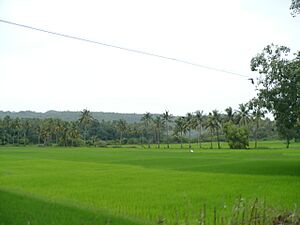
Important forest products include bamboo canes and barks. Coconut palm trees grow all over Goa, except in high areas. Many deciduous trees are found here. These include teak, Sal tree, cashew, and mango trees. Goa's forests also have many medicinal plants.
Foxes, wild boar, and migratory birds live in Goa's jungles. Many bird species like kingfishers, mynas, and parrots are found here. Many types of fish are caught off Goa's coast and in its rivers. Crabs, lobsters, shrimp, jellyfish, oysters, and catfish are important for sea fishing. Goa also has many snakes.
Goa has several famous "National Parks." These include the Salim Ali Bird Sanctuary on Chorão island. Other wildlife sanctuaries are the Bondla Wildlife Sanctuary and Molem Wildlife Sanctuary.
About 33% of Goa's land is government forest. About 62% of this is protected as Wildlife Sanctuaries and National Parks. Including private forests and plantations, the total forest and tree cover is 56.6% of Goa's land area.
Goa's Economy
| Gross State Domestic Product (in millions of Rupees) | |
| Year | GSDP |
|---|---|
| 1980 | 3,980 |
| 1985 | 6,550 |
| 1990 | 12,570 |
| 1995 | 33,190 |
| 2000 | 76,980 |
| 2010 | 150,000 |
Goa's economy is strong. Its total economic output for 2017 was about $11 billion. Goa is India's richest state. It has the highest GDP per person. This is two and a half times higher than the national average. Goa's economy has also grown very fast, at an average of 8.23% per year from 1990–2000.
Tourism is Goa's most important industry. About 12% of all foreign tourists visiting India come to Goa. Goa has two main tourist seasons. In winter, tourists from other countries, especially Europe, visit. In summer, which is the rainy season in Goa, tourists from across India come. Goa's net state domestic product (NSDP) was about $7.24 billion in 2015–16.
The land away from the coast has many minerals. Mining is the second largest industry. Iron, bauxite, manganese, and limestone are mined here. The Mormugao port handled 31.69 million tonnes of cargo in 2007. This was 39% of India's total iron ore exports. Major mining companies include Sesa Goa and Dempo. However, too much mining has reduced forest cover. It has also caused health problems for local people. Some companies are also mining illegally. In 2015–16, Mormugao port handled 20.78 million tonnes of cargo.
Farming is less important to Goa's economy now. But it still provides part-time jobs for many people. Rice is the main farm crop. Other crops include areca, cashew, and coconut. Fishing employs about 40,000 people. However, the importance of fishing has decreased. This is partly because traditional fishing is being replaced by large-scale trawling.
Medium-sized industries in Goa make pesticides, fertilizers, and tires. They also produce footwear, chemicals, and medicines. Other products include wheat items, steel, canned fruits and fish, cashew nuts, and textiles.
Goa has 16 planned Special Economic Zones (SEZs). However, the Goa government recently decided not to allow any more SEZs. This was due to strong opposition from political parties and the Goa Catholic Church.
In 1976, Goa became the first state in India to allow some types of gambling. This allowed the state to collect taxes from gambling. This helped strengthen the economy. There are several casinos in Goa. In 2018-2019, tax revenue from casinos reached Rs 414 crore.
Goa was the second state in India to have a 100% automatic telephone system. It has a strong network of telephone exchanges. As of September 2017, Goa had a total power generation capacity of 547.88 MW. Goa is also one of the few states in India to have 100% rural electricity.
-
A train carrying iron ore to Marmagao Port in Vasco da Gama, Goa.
-
A commercial area in Panaji.
People of Goa
Population and Languages
- Further information: Goans
| Population growth | ||
|---|---|---|
| Year | Pop. | ±% p.a. |
| 1901 | 475,513 | — |
| 1911 | 486,752 | +0.23% |
| 1921 | 469,494 | −0.36% |
| 1931 | 505,281 | +0.74% |
| 1940 | 540,925 | +0.76% |
| 1950 | 547,448 | +0.12% |
| 1960 | 589,997 | +0.75% |
| 1971 | 795,120 | +2.75% |
| 1981 | 1,007,749 | +2.40% |
| 1991 | 1,169,793 | +1.50% |
| 2001 | 1,347,668 | +1.43% |
| 2011 | 1,458,545 | +0.79% |
A person from Goa is called a Goan. In 2011, Goa had 1.459 million residents. This makes it the fourth least populated state in India. Goa's population density is 394 people per square kilometer. This is higher than the national average. Goa has the highest percentage of people living in cities, with 62.17% in urban areas. The ratio of females to males is 973 females for every 1,000 males. In 2007, the birth rate was 15.70 births per 1,000 people.
The Official Language Act of 1987 states that Konkani in the Devanagari script is the only official language of Goa. However, Marathi can also be used for official purposes. Portuguese was the only official language during Portuguese rule. The government also replies in Marathi to letters written in Marathi. Some people want Konkani in the Roman script to also be an official language. But many support keeping Konkani as the only official language.
About 66.11% of people in Goa speak Konkani as their first language. Almost all Goans can speak and understand Konkani. Many people can also speak and understand English. Other languages spoken in Goa include Marathi (10.89%), Hindi (8.64%), Kannada (4.65%), Urdu (2.83%), and Portuguese (1%).
Historically, Konkani was not the official language of Goa's rulers. Under the Kadambas, the court language was Kannada. Under Muslim rule, Persian was the official language. During the Vijayanagara Empire, Kannada and Telugu were used.
Religions in Goa
Religion in Goa (2011) Hinduism (66.08%) Christianity (25.10%) Islam (8.33%) Sikhism (0.10%) Other or not religious (0.39%)
According to the 2011 census, out of 1,458,545 people:
In 1909, the Catholic population in Portuguese Goa was 80.33%. Since the 20th century, the number of Goan Catholics has decreased. This is due to people moving away from Goa. Also, many non-Christians from other parts of India have moved to Goa.
The Catholic community in Goa is served by the Roman Catholic Archdiocese of Goa and Daman. This is the main Catholic area in India.
Fun in Goa: Tourism
Tourism in Goa mostly happens along the coast. There is less tourist activity inland. In 2010, over 2 million tourists visited Goa. About 1.2 million of them were from other countries. As of 2013, Goa was a popular place for Indian and foreign tourists. Many Britons and Russians visited. The state hopes to attract more high-end tourists in the future.
Goa is ranked 6th among the Top 10 Nightlife cities in the world by National Geographic Travel. Water sports are a big attraction in Goa. Beaches like Baga and Calangute offer jet-skiing, parasailing, and banana boat rides. Patnem beach in Palolem was ranked third in CNN Travel's Top 20 Beaches in Asia.
Over 450 years of Portuguese rule has given Goa a unique culture. This culture is a mix of Eastern and Western styles. Portuguese culture has a strong influence on Goa's architecture, culture, and social life. Goa is famous for its beautiful beaches, churches, and temples.
Historic Places and Areas
Goa has one World Heritage Site. This is the Bom Jesus Basilica with other churches and convents of Old Goa. The basilica holds the remains of Francis Xavier. Many Catholics consider him the patron saint of Goa. These buildings show strong Portuguese and European styles. The relics are shown to the public sometimes, not every ten or twelve years as some believe. The last time was in 2014.

| Year | Total Arrivals | % Change |
|---|---|---|
| 1985 | 775,212 | |
| 1990 | 881,323 | |
| 1995 | 1,107,705 | |
| 2000 | 1,268,513 | |
| 2005 | 2,302,146 | |
| 2010 | 2,644,805 | |
| 2015 | 5,297,902 |
The Velhas Conquistas regions are known for their Goa-Portuguese style buildings. Goa has many forts. Some of these are Tiracol, Chapora, Corjuem, and Aguada.
Many old mansions built in the Indo-Portuguese style still stand in Goa. However, some are in poor condition. Fontainhas in Panaji is a cultural area. It shows the life, architecture, and culture of Goa. Portuguese influences can also be seen in some of Goa's temples. These include the Shanta Durga Temple and the Mangueshi Temple. After 1961, many temples were rebuilt in the local Indian style.
Museums and Science Centers
Goa has three important museums. These are the Goa State Museum, the Naval Aviation Museum, and the National Institute of Oceanography. The aviation museum is one of only three in India. The Goa Science Centre is in Miramar, Panaji. The National Institute of Oceanography, India (NIO) is in Dona Paula. The Museum of Goa is a private art gallery in Pilerne Industrial Estate.
Beautiful Beaches
Goa's beauty is largely found on its beaches. The coastline is about 103 kilometers long. It has some of the most attractive beaches along the Arabian Sea. Goa's beaches are considered among the most beautiful in the world. Some popular beaches include Anjuna Beach, Baga Beach, Calangute Beach, Colva Beach, and Miramar Beach.
Goa's Culture
Goan culture is a mix of Eastern and Western styles. This is because it was a Portuguese territory for over 450 years. Western culture has a strong influence. Goa's cultural displays often show religious harmony. They feature symbols like the Deepastambha, the Cross, and Ghode Modni. Traditional European royal clothing is also part of Goa's heritage. Local dances show a unique blend of different religions and cultures.
Important local festivals include Christmas, Easter, and Carnival. Hindu festivals like Diwali, Shigmo, Chavoth, and Dasara are also celebrated. The Goan Carnival and Christmas-New Year celebrations attract many tourists.
The Gomant Vibhushan Award is Goa's highest civilian honor. The Government of Goa gives it out every year since 2010.
Dance and Music
Traditional Goan art forms include Dekhnni, Fugdi, Corridinho, Mando, Dulpod, and Fado.
Goan Hindus enjoy Natak, Bhajan, and Kirtan. Many famous Indian classical singers are from Goa. These include Mogubai Kurdikar and Kishori Amonkar.
Theatre and Performances
Natak, Tiatr (very popular), and Jagor are the main traditional performance arts in Goa. Other forms include Ranmale and Dashavatari. These performances tell stories from the Ramayana and the Mahabharata. They also cover modern social topics with song and dance.
"Jagor" is a traditional folk dance-drama. It is performed by the Hindu Kunbi and Christian Gauda communities in Goa. They perform it to ask for blessings for their crops. The word "Jagor" means "wakeful nights." People believe that the night-long performance awakens the gods once a year. The gods then stay awake to protect the village.
Perni Jagor is an ancient mask dance-drama. It is performed by Perni families. They use wooden masks that look like animals, birds, and supernatural beings.
Gauda Jagor shows social life. It displays different human emotions and characters. It mainly features three characters. They wear shiny clothes and headgears. The performance includes lively Goan folk instruments.
In some places, Jagor performances include both Hindus and Christians. Hindus play the characters, and Christian artists provide the music.
Tiatr (Teatro) and its artists are very important for keeping the Konkani language and music alive. Tiatrs are performed only in the Roman script of Konkani. They are mainly based on the Christian community. They have scenes with music in between. The scenes show daily life and social situations. Tiatrs are often held on weekends. They are performed at places like Kala Academy in Panaji. Western musical instruments like drums, bass, and trumpets are used. Tiatr is one of Goa's art forms known worldwide. Goans in the Middle East, Americas, and Europe enjoy these performances.
Konkani Films
Konkani cinema is an Indian film industry. Films are made in the Konkani language. This language is mainly spoken in Goa, Maharashtra, and Karnataka.
The first full-length Konkani film was Mogacho Anvddo. It was released on April 24, 1950. A. L. Jerry Braganza produced and directed it. Because of this, April 24 is celebrated as Konkani Film Day. Since 2004, the International Film Festival of India has been held permanently in Goa. It takes place every year in November and December. The Konkani film Paltadcho manis was listed among the world's best films of 2009.
Konkani films can win the National Film Award for Best Feature Film in Konkani. As of 2011, the most successful Konkani film was O Maria. In 2012, The Victim became the first digital theatrical Konkani film.
Delicious Food
Rice with fish curry (xit koddi in Konkani) is the main food in Goa. Goan cuisine is known for its many fish dishes. They are cooked with special recipes. Coconut and coconut oil are widely used in Goan cooking. Chili peppers, spices, and vinegar are also used. This gives the food a unique flavor. Goan food is greatly influenced by Portuguese cuisine.
Goan food can be divided into Goan Catholic and Goan Hindu cuisine. Each has distinct tastes and cooking styles. Pork dishes like Vindalho, Xacuti, and Sorpotel are cooked for special events by Goan Catholics. A mixed vegetable stew called Khatkhate is popular during festivals for both Hindus and Christians. Khatkhate has at least five vegetables, fresh coconut, and special Goan spices.
Sannas are local rice cakes. Polle, Amboli, and Kailoleo are rice pancakes. All are native to Goa. A rich, layered baked sweet called bebinca is traditional at Christmas.
The most popular alcoholic drink in Goa is feni. Cashew feni is made from the cashew fruit. Coconut feni is made from the sap of toddy palms. Urrak is another local drink made from cashew fruit juice. Goa also has a strong wine culture because of Portuguese rule.
Goan Architecture
-
Velha Goa Galeria, in Panaji.
Goa's buildings combine native Goan, Ottoman, and Portuguese styles. Since the Portuguese ruled for four centuries, many churches and houses show Portuguese architecture. Goan Hindu houses do not show Portuguese influence. However, modern temple architecture mixes original Goan temple style with other styles. The original Goan temple architecture was lost when temples were destroyed by the Portuguese.
Famous People from Goa
Famous people from Goa include architects, artists, engineers, and governors. There are also lawyers, judges, military personnel, and models. Others are politicians, educators, scientists, athletes, writers, and journalists.
Media and Communication
Goa has almost all the television channels available in India. Channels are received through cable in most parts of Goa. In rural areas, channels are received via satellite dishes. Doordarshan, India's national TV broadcaster, has two free channels.
DTH (Direct To Home) TV services are available from various providers. All India Radio is the only radio channel in Goa. It broadcasts on both FM and AM bands. There are also private FM radio channels. An educational radio channel, Gyan Vani, is run by IGNOU.
Major mobile phone service providers operate in Goa.
Local newspapers include the English language O Heraldo and The Navhind Times. The Times of India and The Indian Express are also available. The Times of India now publishes directly from Goa. Other publications include Planet Goa and Goa Today.
Sports in Goa
While cricket is popular in other states, association football is the most popular sport in Goa. It is a big part of Goan culture due to Portuguese influence. The sport started in Goa in 1883. An Irish priest, Fr. William Robert Lyons, introduced it. The Goa Football Association manages the game in the state. Goa is a major center for football in India. It has many football clubs in the national I-League. Famous clubs include Salgaocar and Dempo.
The first Unity World Cup was held in Goa in 2014. The state's main football stadium is Fatorda Stadium in Margao. It also hosts cricket matches. Goa hosted some matches of the 2017 FIFA U-17 World Cup and the 2022 FIFA U-17 Women's World Cup.
Many Goans have played football for India. Six of them have even captained the national team. Goa has its own state football team and league, the Goa Professional League. Goa is probably the only state in India where football is more important than cricket. Goans are big fans of football teams from Portugal and Brazil.
Goa also has its own cricket team. Dilip Sardesai and Shikha Pandey are the only Goans to have played international cricket for India. Another Goan cricketer, Suyash Prabhudessai, was selected for the IPL.
India (Goa) is a member of the Lusofonia Games. These games are held every four years in a Portuguese-speaking country. They are similar to the Commonwealth Games.
Learning in Goa: Education
Goa had some of India's earliest schools with European support. The Portuguese set up religious schools and local schools for basic education. Saint Paul's College, Goa, founded around 1542, was a Jesuit school. It was once the main Jesuit institution in Asia. It had India's first printing press and published the first books in 1556.
Medical education started in 1801. Goa Medical College, built in 1842, is one of Asia's oldest medical colleges. It has one of the oldest medical libraries. It is Goa's largest hospital and still trains doctors today.
In 2011, Goa had a literacy rate of 87%. This means 87% of people could read and write. 90% of males and 84% of females were literate. Each local area has government-run schools. However, private schools are often preferred. All schools follow the Goa Board of Secondary and Higher Secondary Education syllabus. Some schools also follow the all-India ICSE syllabus. Most students in Goa finish high school with English as the teaching language. However, most primary schools use Konkani and Marathi. More students are choosing English-medium education.
Some notable schools in Goa include Sharada Mandir School and Loyola High School. After ten years of schooling, students go to a Higher Secondary school. They can choose subjects like Science, Arts, Law, and Commerce. Students can also choose vocational studies or diploma courses. After two years of college, they can join a professional degree program. Goa University is the only university in Goa. Most colleges in Goa are connected to it.
There are six engineering colleges in Goa. Goa Engineering College and National Institute of Technology Goa are government-funded. Private engineering colleges include Don Bosco College of Engineering. In 2004, BITS Pilani opened its second campus in Goa. The Indian Institute of Technology Goa (IIT Goa) started in 2016.
There are also colleges for pharmacy, architecture, and dentistry. Many private colleges offer law, arts, commerce, and science courses. Goa also has two centers for Oceanographic Science. These are the National Centre for Antarctic and Ocean Research and the National Institute of Oceanography. Goa Institute of Management is one of India's top business schools.
Due to renewed interest, Portuguese language classes are offered in many schools in Goa. Some Goan students also participate in exchange programs in Portugal.
How to Travel in Goa
Air Travel
Goa has two international airports. Goa International Airport is located near Vasco da Gama, Goa. The Manohar International Airport is in North Goa at Mopa. Within five months of opening, Mopa airport handled 30% of all air traffic in Goa.
Both airports have regular domestic and international flights. The new airport started international flights in March 2023. Goa has international flights to cities in the Middle East. These include Doha, Dubai, Muscat, Sharjah, and Kuwait.
Road Travel
Goa's public transport mainly uses private buses. These buses connect major towns to rural areas. Government-run buses, managed by the Kadamba Transport Corporation, serve main routes. They also reach some remote parts of the state. In big towns like Panaji and Margao, buses operate within the city. However, public transport in Goa is not very developed. People often rely on their own vehicles, like motorcycles and small cars.
Hired transport includes taxis and auto rickshaws in cities. Another way to travel is by motorcycle taxi. These are driven by "pilots." They carry one passenger, and fares are usually negotiated. "Pilots" are often the cheapest way to travel after buses. River crossings in Goa use flat-bottomed ferry boats. These are run by the river navigation department.
Goa has four National Highways. NH-66 connects Goa to Mumbai in the north and Mangalore to the south. NH-4A connects Panaji to Belgaum in the east. NH-366 connects NH-66 to Mormugao Port. The new NH-566 connects Mormugao Port to NH-66 via Dabolim Airport. Goa has 224 kilometers of national highways. It also has 232 kilometers of state highways and 815 kilometers of district highways. National Highways in Goa are among the narrowest in India.
Goa will get two new expressways in the future. These will improve connections with the rest of the country. They are the Nagpur–Goa Expressway and the Konkan Expressway.
Rail Travel
Goa has two rail lines. One is run by the South Western Railway. It connects Vasco da Gama, Goa with Belgaum and Hubli via Margao. The other is the Konkan Railway line. It was built in the 1990s. It runs along the coast and connects major cities on the western coast.
Metro System
In 2018, a metro rail system was planned for Goa. It would connect the capital city of Panaji. In the future, it might extend from South Goa to Karwar in Karnataka.
Sea Travel
The Mormugao Port Trust near Vasco handles minerals, petroleum, coal, and containers. Most shipments are minerals and ores from Goa's inland areas. Panaji has a smaller port on the Mandovi river. It used to handle passenger steamers between Goa and Mumbai.
Sister States
 Hawaii, United States of America
Hawaii, United States of America
See also
 In Spanish: Goa para niños
In Spanish: Goa para niños


